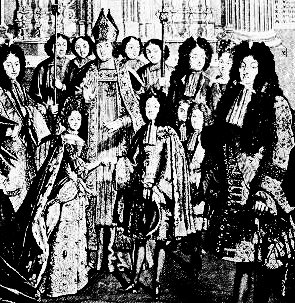|
性行为的发展
|
|
的性行为的发展阶段:
青春期的发展 |
|
性欲行为的发展 4 |
|
在未婚青少年之间的性交可能被人质疑。第一次性交常常是一种令人失望的性体验,尤其对女性来说更是如此,并且因此也许在一段时间里不会再发生。男性因为动作笨拙和缺乏经验,也可能会感到不满足。这样的挫折随着不断的实践通常会被克服。更为严峻的问题是害怕感染上性传播疾病(STDs)和担心非意愿怀孕,这是合乎情理的。所以,重要的是少女和少男都要熟悉性传播疾病的预防和避孕知识。不幸的是,许多少男少女都没有这些必要的知识,或者如果他们去运用这些知识的话,却未能真正奏效。同时,一些青少年采用了一种他们称之为“体外性交(outercourse)”的“安全性行为”方法,即避免阴道插入的性行为。这种方法常常先于首次性交持续达数年之久;因为,传统社会坚持新娘在结婚典礼之前要保持“贞操”,这种方法也可能被传统社会中的未婚情侣所运用。
在这种文化背景里,人们常常忘却了一个基本的事实,那就是人类历史的大部分时间里,青年人在能够结婚之前并不必要等待多久。一旦他们到了青春期,就会开始进入成人生活圈,并能够建立自己的家庭。女性一旦能够生养孩子了,就会被“赋予婚姻”[1],甚至出于经济方面的一些原因,在这些地方的男性不得不等上一些年头(才能结婚),他们也还有其它的性接触机会:旧时的许多社会里,临时的同性性接触和去嫖妓并不会被认为是“不得了的事情”,人们会容忍这些现象。换一句话说,数千年以来,并没有指望年轻人要经历延长如此之久的节欲时间。在青春期之后,社会认可每一个人都随时准备和有资格从事性行为。

早 婚
旧时,低年龄结婚是许多社会里一种普遍的社会规范。在欧洲,直到进入现代许久了,早婚仍用来维护贵族的政治利益。插图所示的是萨伏伊(Savoy,1720-1861)的玛丽·阿德雷德(Marie
Adelaide,12岁)与勃艮第公爵(Duke
of Bourgogne,14岁)于1697年在凡尔赛的婚礼。绘图右侧,可见到新郎的祖父路易十四国王。
Early Marriage
Marriage at an early age was the norm in many societies of the past. In Europe, it served the political interests of the aristocracy well into modern times. Shown here is the wedding of Marie Adelaide of Savoy (age 12) and the Duke of Bourgogne (age 14) at Versailles 1697. King Louis XIV, the bridegroom’s grandfather, can be seen on the right.
|
|
Development of Sexual Behavior |
|
Stages of Development: Adolescence
|
|
Erotic Behavior 4
|
|
Sexual intercourse between unmarried adolescents can be problematical. The first coitus is often a disappointing experience, especially for females, and it may therefore not be repeated for quite a while. Males may also be unsatisfied because of their own clumsiness and lack of experience. Such frustrations are usually overcome with continued practice. A more serious problem is the justified fear of infection with
sexually transmitted diseases (STDs) and the worry about an unwanted pregnancy. It is therefore important that both young females and males know about
STD prevention and
contraception. Unfortunately, many of them do not have the necessary knowledge or, if they do, fail to act on it. Some adolescents have, in the meantime, adopted various techniques of “safer sex” which they call “outercourse”, i.e. intercourse that avoids vaginal penetration. These techniques often precede the first coitus by several years, and they may also be practiced by unmarried couples in traditional societies that insist on the “virginity” of brides on their wedding day.
In this context, it is now often forgotten that,
for the greater part of human history, young people did not have to wait long before they could marry. Once they reached puberty, they were initiated into the community of adults and could start a family of their own. Females were “given in marriage” as soon as they could bear children, and even where males had to wait a few years for some economic reason, they had other sexual opportunities: In many societies of the past, temporary homosexual contacts and visits with prostitutes were not considered “serious” and were silently tolerated.
In other words, for thousands of years, young people were not expected to go through an extended period of sexual abstinence. It was taken for granted that, after puberty, everyone was ready for and entitled to sexual intercourse.
|